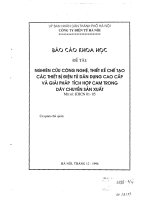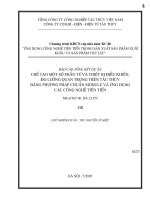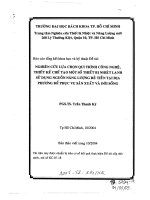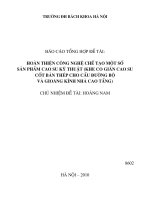Chế tạo một Turbine gió
Bạn đang xem bản rút gọn của tài liệu. Xem và tải ngay bản đầy đủ của tài liệu tại đây (1.29 MB, 17 trang )
www.re-energy.ca
© 2006 The Pembina Institute
Wind Turbine
Designed by Dave Mussell
Introduction.............................................................................................................................................................. 1
Build It!..................................................................................................................................................................... 2
Tools .................................................................................................................................................................... 2
Materials .............................................................................................................................................................. 2
Templates ............................................................................................................................................................ 3
Construction Steps .............................................................................................................................................. 4
Part A. Frame and Base................................................................................................................................... 4
Part B. Making the Coils................................................................................................................................... 7
C. Build the Stator ............................................................................................................................................ 9
D. The Rotor................................................................................................................................................... 10
E. The Turbine ............................................................................................................................................... 12
F. Final Assembly........................................................................................................................................... 14
G. Test It! ....................................................................................................................................................... 15
Troubleshooting Tips ......................................................................................................................................... 16
Acknowledgements............................................................................................................................................ 16
Wind Turbine
Page 1 of 17
www.re-energy.ca
© 2006 The Pembina Institute
Introduction
The Savonius Wind Turbine
These plans are for the construction of vertical axis wind turbine, modelled after a
design by the Finnish engineer S.J. Savonius in 1922. His idea was to mount two
half-cylinders on a vertical shaft. It was simple to build, and could accept wind from
any direction. However, it was somewhat less efficient than the more common
horizontal axis turbine. The reason for the difference has to do with aerodynamics.
Horizontal axis turbines have blades that create lift to spin the rotor, whereas the
vertical axis design we are using here operates on the basis of drag—one side
creates more drag in moving air than the other, causing the shaft spin.
Permanent Magnet Alternator
This wind turbine model makes its electricity with a simple generator which produces pulses of current, or
alternating current. It does so by passing strong magnets over coils of fine wire. Each time a magnet passes
over a coil, the coil becomes energized with electricity. With 4 coils connected together in series, the result is a
quadrupling of the voltage.
This is the simplest and possibly most efficient way to generate electricity, and is the same basic principle used
in almost all wind turbines, even the large scale commercial ones. The electricity from a wind turbine varies with
the wind speed, so to make practical use of it, you must be able to store it in batteries, or change it into a form
that gives a stable, constant voltage. Usually, electricity from wind turbines is converted from alternating current
to direct current, which can be used for battery charging. You can find plans on the Internet for simple electronic
devices called bridge rectifiers. Bridge rectifiers consist of just 4 diodes, and can be made for just a few
dollars.
Safety Precautions
Utility knives and scissors can be dangerous! Use caution
when cutting materials using them. The blades of most utility
knives can be extended and locked in place. Extend the
blades only far enough to cut all the way through the
material, no farther. Be sure they are locked in position while
cutting.
Hot glue guns can cause serious burns, as can the glue if it
comes in contact with your skin.
The magnets you will be using can cause serious damage to
computers or other electronic devices. Be sure to keep them
away from credit cards, computer disks, audio tapes, or any
other materials on which information is stored magnetically.
Wind Turbine
Page 2 of 17
www.re-energy.ca
© 2006 The Pembina Institute
Build It!
Tools
Materials
Quantity Item Sources
1 Clear plastic water bottle, 1.5L size Grocery and convenience stores, recycling bins
1 Base 14cm by 25cm, 2cm thick,
plywood, particle board, or lumber
(1x6)
Hardware or home improvement store, or wood
scraps
120m
(approx.)
28 gage enamelled magnet wire Electric motor repair shops, electrical supply
houses.
4 Rare earth disk magnets (2-2.5cm
dia.)
Lee Valley Tools (www.leevalleytools.com);
eBay.
80 to
100cm
Square dowels: 2 pcs. 30cm long,
and 1 piece 20cm long
Most hardware and home improvement stores.
1 Round wooden dowel (6mm or ¼”)
30 cm long
Hardware or home improvement store.
1 Light emitting diode (LED 5mm
size,
Electronics supply store (in Canada: The
Source / Circuit City)
4 Fender washers (3cm diameter) Hardware store
1 Wood screw (#8, 5/8ths inch,
square recess)
Hardware store
1 Screw eye (25mm or 7/8”) Hardware store
1 Corrugated cardboard or
foamboard, 60 cm by 20 cm
(approximately)
Recycling bin or stationery store, or art supply
store.
6 Braces (3cm pieces of square
dowel, both ends cut at 45
degrees)
Cut from a short length of square dowel, or
substitute other material. For supporting the
uprights.
1 White glue (small bottle) Stationery or hardware store
Wind Turbine
Page 3 of 17
www.re-energy.ca
© 2006 The Pembina Institute
Templates
Instructions: glue this page to cardboard and cut out the shapes with utility knife.
Wind Turbine
Page 4 of 17
www.re-energy.ca
© 2006 The Pembina Institute
4. Add braces to support the frame, as shown.
5. A fully braced upright.
Construction Steps
Part A. Frame and Base
For this part, you will need:
1. Use a pencil, ruler, and compass to mark the base board according to the dimensions in the diagram below:
Tools:
• Hot glue gun, glue sticks
• Pencil sharpener
• Screw driver
• Ruler
• Compass
Materials:
• Base board (14cm x 25cm)
• Uprights (30 cm square dowel, 2 pieces)
• Crossbar (20cm square dowel, 1 piece)
• Screw
• Braces
• Round Dowel
2. Drive the screw into the center point of the base
board.
3. Using hot glue, fasten the 30 cm long square dowels
to the frame as shown. Use a ruler or square to ensure
they are perpendicular.
Wind Turbine
Page 5 of 17
www.re-energy.ca
© 2006 The Pembina Institute
6. Using the ruler, find and mark the center of the
cross bar.
7. Test the dowel in the screw eye for fit. It should be
loose, but with little play. Resize the screw eye as
necessary.
8. Turn the screw eye into the cross bar at the center
point.
9. Sharpen the end of the dowel using the pencil
sharpener.









